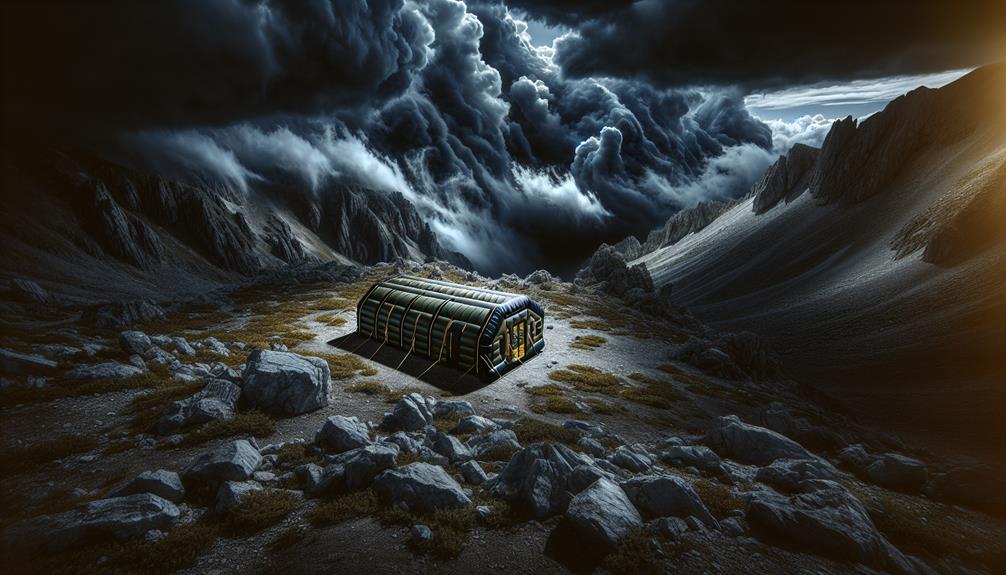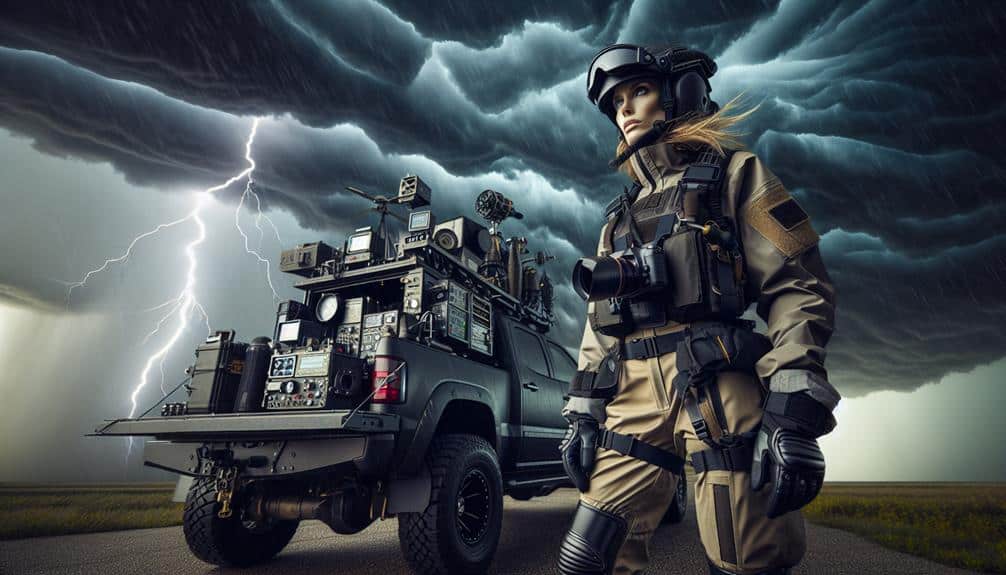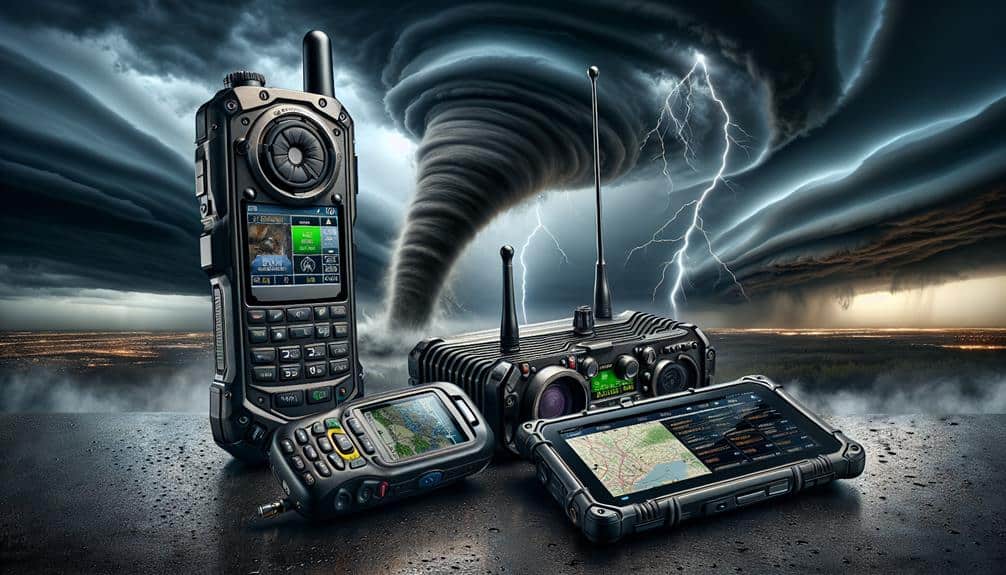We've pinpointed the top seven storm chaser shelter options based on strict technical criteria. Portable storm shelters, featuring advanced materials and modular setups, offer rapid deployment. Reinforced vehicles with armored exteriors and enhanced mobility ensure both safety and maneuverability. Underground bunkers provide unmatched protection with steel-reinforced concrete and extensive ventilation systems. Mobile safe rooms and inflatable shelters offer versatile on-the-go protection. Storm-resistant tents, built from high-strength materials, and public safe houses, constructed per strict codes, complete our list. Each option excels in structural integrity and rapid accessibility, essential for storm chasers looking for thorough protection. Discover how each excels in specific conditions.
Key Points
- Portable storm shelters are lightweight, rapidly deployable, and can withstand winds exceeding 200 mph.
- Reinforced vehicles offer bullet-resistant glass, advanced suspension, and cutting-edge weather monitoring instruments for safety and data collection.
- Mobile safe rooms provide customized, lightweight designs that fit vehicle specifications and offer quick deployment for on-the-go protection.
- Inflatable shelters offer rapid deployment, flexibility, and robust protection, ideal for emergency responses and severe weather conditions.
Portable Storm Shelters
When seeking safety on the go, portable storm shelters offer a practical solution with their lightweight design and rapid deployability. These shelters are engineered to provide maximum protection while guaranteeing ease of transport and setup.
The sophisticated shelter design often incorporates advanced materials like reinforced steel and high-density polyethylene, guaranteeing they meet rigorous safety standards yet remain easy to carry and deploy.
In emergency preparedness, response time is critical. Portable storm shelters excel in this domain by allowing us to set them up within minutes. Many models feature modular components that snap together quickly, and some even include anchor systems for added stability.
These shelters are compact when stored, taking up minimal space in our vehicles, which is essential for storm chasers who need to travel light.
We can also appreciate the data supporting their effectiveness. Studies have shown that well-designed portable shelters can withstand winds exceeding 200 mph, offering a reliable refuge during severe weather events.
Reinforced Vehicles
Let's examine reinforced vehicles, focusing on their armored features, safety enhancements, and mobility.
These vehicles often include ballistic glass, reinforced frames, and advanced suspension systems to withstand extreme weather conditions.
Armored Vehicle Features
Armored vehicles, equipped with strengthened steel exteriors and bullet-resistant glass, provide enhanced safety for storm chasers facing extreme weather conditions. These vehicles are designed with heavy-duty construction to withstand the severe impacts of debris and high winds. The integration of bullet-resistant windows ensures that we remain protected from flying objects, a common hazard in storm-chasing scenarios.
Strengthened doors are another essential feature, engineered to resist deformation and maintain integrity under extreme stress. These doors often come with secure locking mechanisms to prevent accidental openings due to sudden pressure changes or forceful impacts. By incorporating these elements, the vehicle becomes a reliable sanctuary in volatile environments.
Additionally, the heavy-duty construction of these vehicles includes fortified frames and suspension systems capable of handling rough terrains and sudden obstacles that are often encountered during storm pursuits. This robust build not only increases the safety of the occupants but also enhances the vehicle's overall durability and performance.
We value the freedom to explore the most intense weather phenomena safely. Armored vehicles with these specialized features enable us to push boundaries and gather essential data without compromising our well-being. This balance of safety and freedom is paramount in our storm-chasing endeavors.
Safety Enhancements
Incorporating strengthened vehicles into our storm-chasing toolkit greatly enhances our safety by utilizing advanced materials and engineering techniques designed to withstand extreme weather conditions. These specialized vehicles are essential for emergency preparedness and effective weather monitoring. They offer superior structural integrity and impact resistance, ensuring that we remain protected from flying debris and other hazards during severe storms.
Our strengthened vehicles employ high-quality steel, Kevlar, and other state-of-the-art materials, providing unmatched durability. In addition, they often feature fortified glass and specialized bracing systems that further strengthen the structure. This advanced engineering significantly decreases the risk of structural failure, even when subjected to high-impact forces.
Moreover, these vehicles are equipped with cutting-edge weather monitoring instruments, allowing us to gather crucial data in real-time. This capability is vital for making informed decisions and adapting our strategies to rapidly changing weather conditions.
Mobility and Access
Our reinforced vehicles not only enhance safety but also greatly improve our mobility and access to storm-affected areas. With advanced suspension systems and all-terrain tires, our vehicles can traverse challenging landscapes, guaranteeing we reach important zones quickly. The integration of robust engines provides the necessary power for swift maneuvers, while the reinforced chassis offers stability even in extreme conditions.
Accessibility is a key focus in our vehicle design. Each unit is equipped with strategically placed emergency exits, ensuring rapid egress in case of an unforeseen event. This feature is essential for maintaining safety while allowing for quick deployment of equipment and personnel. Additionally, the design includes hydraulic lifts and ramps, facilitating easy loading and unloading of gear, which is crucial for efficient operations.
Maneuverability is another crucial aspect. Our vehicles are engineered for optimal turning radius and responsive steering, allowing us to navigate tight spots that would typically be inaccessible. This capability is vital for getting as close as possible to the storm's core, where data collection is most effective. By prioritizing these elements, we guarantee not only our safety but also our operational efficacy in the field.
Underground Bunkers

Let's examine the benefits of underground bunkers, focusing on enhanced safety measures, long-term durability, and installation considerations.
These shelters provide superior protection against extreme weather events, boasting reinforced concrete and steel structures.
We'll also address the logistical aspects of installing such bunkers, including site selection and regulatory compliance.
Enhanced Safety Measures
Underground bunkers consistently provide the highest level of protection for storm chasers, leveraging fortified materials and advanced engineering to withstand extreme weather conditions. To guarantee our bunkers are optimally efficient, we must focus on enhanced safety measures rooted in emergency preparedness and shelter design. These measures are essential for safeguarding our lives when nature's rage is released.
- Superior Construction Materials: Utilizing steel-reinforced concrete and advanced composites enhances structural integrity, ensuring our shelter remains intact even during the most violent storms.
- Incorporated Ventilation Systems: Proper airflow prevents suffocation and maintains air quality, vital for survival during extended stays underground.
- Thorough Safety Protocols: Including well-defined evacuation routes and access to community resources ensures we can exit safely or receive help if needed.
When designing our shelter, we prioritize emergency preparedness by incorporating features like backup power supplies and secure storage for food and water. Additionally, clearly marked evacuation routes are crucial, allowing us to navigate out of the bunker swiftly if conditions change.
Long-Term Durability
To guarantee the long-term strength of underground bunkers requires meticulous attention to material selection, structural design, and regular maintenance protocols. We must prioritize shelter materials that offer high resistance to corrosion, such as reinforced concrete, galvanized steel, or fiberglass composites. These materials not only withstand the test of time but also provide peak structural integrity under extreme weather conditions.
During construction, it's vital to incorporate advanced weatherproofing techniques. Implementing waterproof membranes, drainage systems, and proper sealing around entry points can prevent water intrusion, which is a common cause of structural degradation. Additionally, we should consider installing ventilation systems that manage humidity levels, further protecting against mold and mildew.
Regular maintenance plays a significant role in long-term durability. We recommend routine inspections to identify and address any potential issues such as cracks, water leaks, or corrosion. Applying protective coatings and conducting necessary repairs in a timely manner will ensure the bunker remains in prime condition.
Installation Considerations
When considering the installation of underground bunkers, we must evaluate site-specific factors such as soil composition, water table levels, and local building codes to guarantee stability and compliance. Without addressing these essential elements, we risk compromising the bunker's structural integrity.
To secure a successful installation, let's focus on three main aspects:
- Structural Integrity and Ventilation Options: We need to select materials that can withstand soil pressure and moisture. High-quality concrete or steel are excellent choices. Proper ventilation systems must be integrated to maintain air quality and prevent moisture buildup, which could lead to structural issues over time.
- Size Considerations and Ease of Assembly: The bunker's size should be tailored to accommodate the number of occupants and essential supplies. Prefabricated sections can simplify assembly, reducing installation time and labor costs. Modular designs also offer flexibility in expanding or downsizing the shelter as needed.
- Compliance with Local Building Codes: Adhering to regional regulations is essential. We should consult with local authorities and professionals to ensure the bunker meets all legal requirements, including safety standards and zoning laws. This step not only secures legality but also optimizes the shelter's performance and reliability.
Mobile Safe Rooms
Mobile safe rooms provide an essential solution for storm chasers seeking reliable, on-the-go protection against severe weather conditions. These shelters are designed with our specific needs in mind, offering both customized designs and lightweight options to guarantee maximum efficiency and portability.
When we're out in the field, the ability to quickly deploy a safe room can mean the difference between life and death. Customized designs allow us to tailor the safe room to fit our vehicle specifications and personal requirements. Whether it's a compact unit for a smaller vehicle or a more spacious design for larger setups, these customized solutions guarantee that we've the best possible protection without compromising on mobility.
Lightweight options are critical for maintaining the balance between safety and ease of transportation. Advanced materials like reinforced steel and composite polymers contribute to the structural integrity of the safe room while keeping the overall weight manageable. This guarantees we can move swiftly and adapt to rapidly changing weather conditions without being bogged down by cumbersome equipment.
In essence, mobile safe rooms offer a blend of adaptability and robust protection, empowering us to chase storms with confidence and security.
Inflatable Shelters

Inflatable shelters offer a rapid-deployment solution for storm chasers, providing both flexibility and robust protection in a lightweight, easily transportable form. These shelters are engineered to withstand harsh weather conditions while ensuring ease of setup, making them an essential tool for those of us who value mobility and safety during storm chases.
One of the key advantages of inflatable shelters is the ability to customize designs tailored to specific needs. Whether we require additional compartments for equipment storage or reinforced sections for added safety, these shelters can be adapted to meet our precise requirements. This flexibility is vital for maintaining operational efficiency in unpredictable environments.
In addition, inflatable shelters excel in emergency response scenarios due to their rapid deployment capabilities. Their compact storage form allows for quick inflation and setup, ensuring that we've a secure base of operations in minutes rather than hours.
Here are three key features of inflatable shelters:
- Lightweight and portable: Easy to transport and carry, perfect for on-the-go storm chasers.
- Rapid deployment: Can be set up in minutes, essential during emergency response situations.
- Custom designs: Tailored configurations to suit specific needs and enhance operational efficiency.
These attributes make inflatable shelters an indispensable asset for storm chasers who prioritize freedom and adaptability.
Storm-Resistant Tents
Storm-resistant tents provide a durable and reliable shelter option, engineered to withstand extreme weather conditions and ensuring our safety during intense storm chases. These tents are crafted from high-strength materials like ripstop nylon and polyester, known for their exceptional tent durability and superior weather resistance. Reinforced seams and robust guy lines help maintain structural integrity, even when faced with high winds and torrential rain.
In terms of portable shelter mobility, storm-resistant tents excel. Their lightweight construction and compact design make them easy to transport, allowing us to quickly relocate as storm conditions shift. Setup ease is another critical factor; these tents typically feature intuitive designs and quick-assembly frames, enabling rapid deployment when time is of the essence.
Data-driven analyses show that tents with a high hydrostatic head (measured in millimeters) offer superior water resistance. For example, a tent with a 3000mm rating can effectively repel water under severe storm conditions, ensuring we remain dry. Additionally, aerodynamic designs reduce wind load, further enhancing their stability.
Public Safe Houses

While storm-resistant tents offer excellent protection on the go, public safe houses provide a more permanent and fortified shelter option during severe weather events. These facilities, such as community centers and school gyms, are designed to withstand extreme weather conditions and provide sanctuary for individuals seeking safety. Public safe houses are strategically located in areas prone to severe storms, making them accessible when needed most.
Let's explore the key features of these emergency shelters:
- Structural Integrity: Public buildings used as emergency shelters are constructed with reinforced materials, often following strict building codes. This guarantees they can withstand high winds, heavy rain, and other storm-related stresses.
- Capacity and Space: Community centers and school gyms offer ample space to accommodate large groups. This is crucial during widespread evacuations, providing enough room for people to stay comfortably and safely.
- Essential Amenities: These shelters are typically equipped with essential amenities such as restrooms, first aid supplies, and emergency communication systems. These facilities enhance the safety and well-being of occupants during their stay.
Frequently Asked Questions
How Can I Stay Updated on Upcoming Storms While on the Go?
We can stay updated on upcoming storms by using mobile notifications and weather radar apps. These tools provide real-time storm tracking and emergency communication, ensuring we have the precise data we need while on the go.
What Emergency Supplies Should I Carry in a Storm Shelter?
Did you know 60% of storm-related injuries occur during sheltering? To stay safe, let's carry emergency food, water, a first aid kit, and a flashlight. These essentials guarantee we're prepared for any storm scenario.
Are There Any Storm Chaser Apps That Provide Real-Time Alerts?
Yes, there are storm chaser apps that provide real-time alerts. These apps offer precise storm tracking and location-based notifications, ensuring accuracy. We recommend RadarScope and Storm Shield for their detailed data and reliable performance.
What Training or Certifications Are Recommended for Storm Chasers?
Imagine we're sailors braving a storm; having safety protocols and field experience is like knowing how to navigate the waves. We recommend training in meteorology, emergency management, and obtaining certifications like SKYWARN to guarantee our safety.
How Do I Find Reliable Weather Forecasts Specific to My Location?
To find reliable weather forecasts specific to our location, we can use local weather resources such as the National Weather Service. Additionally, we recommend weather apps like RadarScope for precise, data-driven updates tailored to our area.


